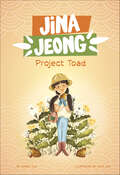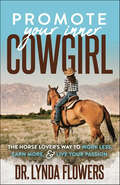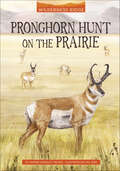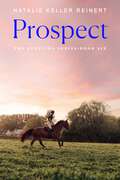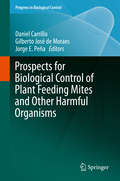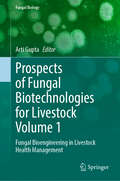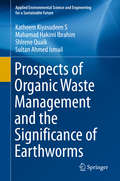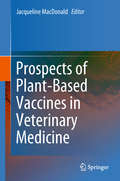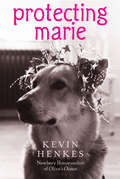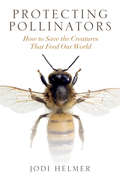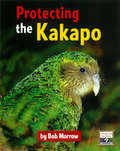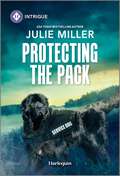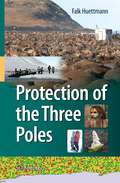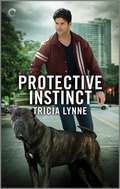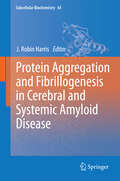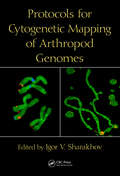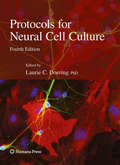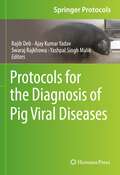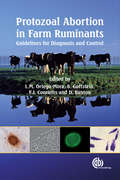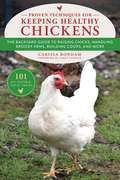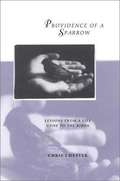- Table View
- List View
Project Toad (Jina Jeong)
by Carol KimA visit to the zoo opens Jina’s eyes to an endangered species in her very own state. She finds out she gets to help with a project to save this animal. But there’s a small problem. The animal is far from being cute and cuddly like her beloved panda bears. Will Jina overcome her reluctance and make a difference after all?
Promote Your Inner Cowgirl: The Horse Lover’s Way to Work Less, Earn More, and Live Your Passion
by Lynda FlowersFor those who have denied their inner cowgirl for far too long, it is time to level up, jump back in the saddle, and return to life’s passion with Promote Your Inner Cowgirl.Lifelong cowgirl, entrepreneur, and nurse practitioner, Dr. Lynda Flowers has the answer. Throughout her life she’s had to balance the rigors of work and family with time to enjoy her love of horses. Now, after founding several startups, including her cowgirl coaching business, Dr. Flowers guides fellow horse lovers away from their frustration and toward the lifestyle they’ve always wanted. In Promote Your Inner Cowgirl, Dr. Flowers sets forth a framework to launch a business, generate income, and free up time to do what horse lovers love, along with how to:Set boundaries while aligning their goals and passionsStand out as a leader and team playerFind and launch a business that worksTurn past failures into future successesIdentify a team that is supportive
Pronghorn Hunt on the Prairie (Wilderness Ridge)
by Thomas Kingsley TroupeAdrina can’t wait to go pronghorn hunting in Wyoming with her dad and uncle. Her obnoxious cousin Frankie is coming too. She’s determined to ignore him as the family sets off on their trip. But soon, Frankie takes his jokes on Adrina way too far. Things get even worse when he misses a pronghorn and blames it on Adrina. Will the cousins be able to get along again and salvage the rest of the hunt?
Pronghorns (Nature's Children)
by Elma SchemenauerDescribes the physical features, natural environment and habits of pronghorns who should be considered part of the goat family.
Proper Badger Would Never Trash the Classroom!
by Lauren GlattlyProper Badger would never go to school . . . or would he?Proper Badger is going to school. It's possible he got on the wrong bus, but he's always wanted to go school, and after all, he looks exactly like all of the other well-behaved, well-mannered students. He can't wait to get tons of gold stars. He has heard gold stars are crunchy and delicious. He will be on his very best badger behavior.Take a bite out of the macaroni art? Release the classroom butterflies? Have the class pet for lunch? He would NEVER!From author Lauren Glattly and New York Times bestselling illustrator Rob Sayegh Jr. comes a hilarious tale about a well-intentioned badger whose wild instincts just can't be suppressed."Uproarious shenanigans that will keep readers properly giggling."--Kirkus Reviews
Prospect: A Novel (The Eventing Series)
by Natalie Keller ReinertThe sixth book in Natalie Keller Reinert’s beloved Eventing Series, set in the high-stakes world of three-day eventing, now reimagined and repackaged!This time, Jules might finally be in over her head. Pete is away in California, and Jules’ promising new horse, Confident Liar, is proving to be a tough ride. Not to mention, her employers are putting the pressure on, expecting more from Jules than she can possibly provide. And Evan Folkes is dangling a shot at international competition that Jules is hard-pressed to resist. She has the support of her old friends and her beloved students, but she’s being pulled in a million different directions.No one is going to wait around while Jules figures out what she wants. On a collision course with the confrontational head of the co-op board, and without Pete to turn to for advice, Jules is drawn back toward her coach. Evan has always wanted to be more than friends, but he’s never been trustworthy. Jules might be risking everything in her attempt to please everyone. She thought she could have it all—but was that too good to be true?In Natalie Keller Reinert’s beloved eight-book Eventing Series, we follow Jules and her friends through the joys and heartbreaks of the competitive eventing circuit, as they work their way into elite echelons—and into one another’s lives and hearts. Utterly immersive and propulsive, this series is an unforgettable journey for anyone who has ever fallen in love with horses, or humans.
Prospects for Biological Control of Plant Feeding Mites and Other Harmful Organisms
by Daniel Carrillo Gilberto José Moraes Jorge E. PeñaThe history of biological control of harmful organisms by mites is marked by outstanding achievements with a few premiere natural enemies. Early works concentrated on the use of predatory mites for the control of synanthropic flies, More recently, the focus has been mostly on mites of the family Phytoseiidae for the control of plant feeding mites. This is an important family of acarine predators of plant pest mites, which are effectively used in agriculture worldwide. Besides the vast knowledge in several species in this family, there are as well many opportunities for biological control, represented in an array of organisms and through the improvement of management techniques, which are constantly explored by researchers worldwide. This has resulted in an increasing interest in predatory mite species within the families Stigmaeidae, Ascidae, Laelapidae, Rhodacaroidea, Macrochelidae, Erythraeidae and Cheyletidae, among others. This book will compile important developments with predatory mite species within these families, which are emerging as important tools for integrated pest management. New developments with predatory insects and pathogenic organisms attacking mites will also be a subject of this book. Finally, the potential and gaps in knowledge in biological control of acarine plant pests will be addressed.
Prospects of Fungal Biotechnologies for Livestock Volume 1: Fungal Bioengineering in Livestock Health Management (Fungal Biology)
by Arti GuptaThis multi-volume set covers a great amount of research done on fungal infection, emphasizing relevant data in the discussion. It is intended to address the major causes of fungal biotechnological aspects while bringing in the most recent data concerning discoveries in livestock management. Each volume in the set will give readers the necessary information, complemented by areas of focus of the accompanying volumes. The set covers topics spanning from basic concepts to health management to engineering using cell lines and approaching bioprocess technology, with a particular focus on recent developments. Volume 1 discusses the different ways in which fungal biotechnologies can be used to improve livestock health, including through the use of probiotics and biocontrol agents. How assisted reproduction technologies have played a crucial role in enhancing livestock production from a domestic practice to a commercial enterprise is addressed in this publication.The book also delves into the current therapy applied to deal with fungal infections, as well as innovations in the livestock field. Lastly this book touches upon the potential economic benefits that these biotechnologies can bring to farmers and stakeholders.
Prospects of Organic Waste Management and the Significance of Earthworms
by Katheem Kiyasudeen S Mahamad Hakimi Ibrahim Shlrene Quaik Sultan Ahmed IsmailThe main aim of this book is to bridge the gap between aerobic and anaerobic waste treatments by concentrating on studies of earthworms. In particular, vermicomposting is being discussed as well as its properties and applications. Other subjects touch on the treatment of palm oil mill effluents, the various importance of earthworms, its scope and future aspects of earthworm research, and the impact of waste management practices on human health.
Prospects of Plant-Based Vaccines in Veterinary Medicine
by Jacqueline MacDonaldThis book provides an in-depth explanation of the advantages and current limitations of recombinant plant-made vaccines for use in veterinary medicine, including for livestock, pets, and wild animals. Written by top scientists in the field, it discusses the background to and latest scientific advances in plant-made vaccines for the most commonly targeted veterinary infections. With the recent high-profile research into recombinant plant-made therapeutics for Ebola and Zika viruses, it is likely that the products will be commercialized and widely used in the future. Plant-made therapeutics have a variety of advantages over those made in traditional systems; however, their most fruitful application may be in veterinary medicine, due to less stringent regulations and a greater need for low-cost products.
Protect Your Pet: More Shocking Facts
by Ann M. MartinFrom the Book jacket: ANN N. MARTIN is internationally recognized as an authority on the commercial pet food controversy. Her book, Food Pets Die For: Shocking Facts About Pet Food, was the first book to expose the hazards of commercial pet food. In Protect Your Pet Ms. Martin continues her thorough and revealing investigation of commercial pet foods as well as other pet-related issues, including the dangers of over-vaccination, the increased cancer rate in companion animals, the raw-meat diet debate, and more.
Protecting Marie
by Kevin HenkesRelates twelve-year-old Fanny's love-hate relationship with her father, a temperamental artist, who has given Fanny a new dog.
Protecting Pollinators: How to Save the Creatures that Feed Our World
by Jodi HelmerWe should thank a pollinator at every meal. These diminutive creatures fertilize a third of the crops we eat. Yet half of the 200,000 species of pollinators are threatened. Birds, bats, insects, and many other pollinators are disappearing, putting our entire food supply in jeopardy. In North America and Europe, bee populations have already plummeted by more than a third and the population of butterflies has declined 31 percent.Protecting Pollinators explores why the statistics have become so dire and how they can be reversed. Jodi Helmer breaks down the latest science on environmental threats and takes readers inside the most promising conservation initiatives. Efforts include famers reducing pesticides, cities creating butterfly highways, volunteers ripping up invasive plants, gardeners planting native flowers, and citizen scientists monitoring migration. Along with inspiring stories of revival and lessons from failed projects, readers will find practical tips to get involved. They will also be reminded of the magic of pollinators—not only the iconic monarch and dainty hummingbird, but the drab hawk moth and homely bats that are just as essential. Without pollinators, the world would be a duller, blander place. Helmer shows how we can make sure they are always fluttering, soaring, and buzzing around us.
Protecting the Kakapo (Fountas & Pinnell LLI Red #Level O)
by Bob MorrowA funny-looking flightless parrot struggles back from the brink of extinction. Meet the kakapo, one of the world's most unusual and endearing birds.
Protecting the Pack (Protectors at K-9 Ranch)
by Julie MillerWhen a terror campaign goes awryA cop, a foster mom and a canine protector are on the case Foster mom Stella Smith and Officer Joe Carpenter&’s makeshift family unit is threatened with the arrival of two new vulnerable foster boys and a terror campaign waged by the boys&’ biological mother&’s violent boyfriend. When threats and extortion fail, the culprit resorts to kidnapping at gunpoint, leaving Stella injured and the kids fighting for survival. It will take a fearless cop—and a fiercely loyal canine—to face down a monster and bring the children home alive.From Harlequin Intrigue: Seek thrills. Solve crimes. Justice served.Discover more action-packed stories in the Protectors at K-9 Ranch series. All books are stand-alone with uplifting endings but were published in the following order: Book 1: Shadow SurvivorsBook 2: K-9 DefenderBook 3: Special Forces K-9Book 4: Protecting the PackBook 5: Crime Scene K-9
Protection of the Three Poles
by Falk HuettmannThe Arctic, the Antarctic, and the Hindu Kush-Himalayas form a trio of terrains sometimes called "the three poles". Mainly composed of rock, snow, and ice, these precious regions, which are home to many unique species such as the polar bear, the emperor penguin, and the snow leopard, contain the primary water resource of this planet and directly shape our climate. This book presents a first-ever global assessment and progressive review of the three poles and demonstrates the urgent need for their protection. Sins of the past have irrevocably harmed and threatened many of the unique qualities of these regions, and the future looks bleak with the global population forecast to reach 9 billion by 2060, and with climate change on the rise. Presented here is a wide-reaching and coherent overview of the three poles' biodiversity, habitats, and ongoing destruction. Failed protection and social targets set by the United Nations and other bodies are exposed while economic growth, unconstrained or inappropriate development, and urban sprawl are promoted unabated. Polar regions play a major role in the global agenda as they are rich in oil and other resources, marking them for contamination, overfishing, and further degradation. Tourism in the Antarctic has benefited from enlightened self-regulation, but there are signs that this is changing, too. The chapters of this book are written by experts in their fields, and their evidence leaves no doubt that we already live beyond our carrying capacity on a finite but decaying space. A global protection role model and several outlook scenarios are proposed to help set in motion polar protection priorities that are actually valid. Humanity has demonstrated through international treaties such as the Antarctic Treaty and the Madrid Protocol that we can put the interests of the planet as a whole first. This must become the norm, not the exception.
Protective Instinct (The Unlovabulls #1)
by Tricia LynneIf NFL player Brody Shaw wants to retire from his hometown team, the Dallas Bulldogs, he needs to keep his head down and his nose clean. When the stray dog he rescued bites the pet sitter, it sets off an avalanche of bad publicity, and it’s time to bring in a professional. Dog-trainer Lily Costello has no intention of training Brody’s dog, CC—football players are bad news, and Brody Shaw is a player if she’s ever met one. Then she sees the brand on CC’s stomach. She came from a puppy mill—the very one Lily is trying to find and shut down. Brody is all in to help the curvy trainer, and with his clout and connections, Lily finally has a lead. But it’s not long before they attract the wrong kind of attention. When someone makes it clear that they’ll stop at nothing to halt the search, it’ll take everything Brody and Lily have to escape with their lives…The UnlovabullsBook 1: Protective Instinct
Protein Aggregation and Fibrillogenesis in Cerebral and Systemic Amyloid Disease (Subcellular Biochemistry #65)
by J. Robin HarrisThis volume of the Subcellular Biochemistry series is the result of the long-standing research interest of the editor in the molecular mechanism underlying Alzheimer's disease and other amyloid diseases, indicated also by the earlier book in the series (Volume 38), devoted to Alzheimer's disease. The broad coverage within the present amyloidogenesis book represents an attempt to collate current knowledge relating to the proteins and peptides involved in most of the known amyloid diseases, together with some amyloid/fibril-forming proteins and peptides that are not involved in diseases. Thus, the range of topics included is comprehensive and furthermore it was thought appropriate to include both basic science and clinical presentation of the subjects under discussion.
Protein Machines, Technology, and the Nature of the Future
by Wyatt GaluskyThis book explores the relationships between humans, chickens, and environments in the context of protein production. The history of these relationships reveals them to be increasingly technological, which results in humans becoming more responsible for those animals and their environments. Understanding this development through the configuration of various kinds of protein machines is key to confronting the kinds of future we wish to promote, and the characteristics of the present we wish to sustain. The book is organized around narratives that explore the concept of the protein machine, with a particular focus on the development of the chicken as it has moved from the field to the factory to the laboratory. These transformations are interconnected, and culminate in efforts to cultivate meat without the animal. Our ultimate goal will be to ask what kind of future does this technology envision, and what roles do humans and animals play in it?
Protocols for Cytogenetic Mapping of Arthropod Genomes
by Igor V. SharakhovArthropods are important to worldwide agriculture, food safety, human health, and energy production. Besides their practical significance, various species represent excellent model systems for biological investigations of evolution, development, physiology, reproduction, and social interaction. For these reasons, arthropod genomics is receiving inc
Protocols for Neural Cell Culture
by Laurie C. DoeringSince the conception of this acclaimed series of volumes examining neural tissue culture, the expansion of neuroscience has continued to produce vital discoveries that utilize tissue culture methodologies. The expert contributors to the fourth edition of Protocols for Neural Cell Culture refine existing protocols and present the emerging new techniques and culture media formulations linked with the many advances in neuroscience. While highlighting updated experimental procedures for many of the classical neural tissue culture preps, the volume addresses topics such as regenerative medicine and the methods to grow and expand embryonic and adult neural stem cells. Essential techniques for the isolation, expansion, and cryopreservation of neural tissue from mouse, rat, and human sources are covered, as well as methods to assess aspects of cell function (calcium imaging) and cell death. With its detailed, step-by-step laboratory protocols, this volume provides the kind of detailed description and implementation advice that is crucial for getting optimal results. Authoritative and cutting-edge, Protocols for Neural Cell Culture, Fourth Edition continues the previous editions' tradition of exceptional quality and thorough coverage in tissue culture protocols for today's neuroscience in order to inspire researchers in the field to further explore this imperative area of study.
Protocols for the Diagnosis of Pig Viral Diseases (Springer Protocols Handbooks)
by Yashpal Singh Malik Rajib Deb Ajay Kumar Yadav Swaraj RajkhowaThis detailed book explores new molecular biological techniques for the detection of both antigens and antibodies of porcine diseases. Assays examined within this collection include improved methods of nucleic acid extraction, polymerase chain reaction (PCR), droplet digital PCR (ddPCR), polymerase spiral reaction (PSR), cross-priming amplification (CPA), enzyme-linked immunosorbent assay (ELISA), as well as peptide nucleic acid (PNA) based tools, aptamer-based tools, and lateral flow assays and different immune assay-based diagnostics for porcine diseases. As part of the Springer Protocols Handbooks series, the present book contains the type of in-depth knowledge on important diagnostics tools that provide a vital source of information for scientists, researchers, and students from different fields. Authoritative and practical, Protocols for the Diagnosis of Pig Viral Diseases aims to guide researchers toward developing new technologies for the diagnosis of pig pathogens.
Protozoal Abortion in Farm Ruminants: Guidelines for Diagnosis and Control
by Luis M. Ortega-Mora Bruno Gottstein Franz J. Conraths David BuxtonProtozoal diseases cause abortion in ruminants and therefore its diagnosis is vital in improving the health and welfare of farm livestock. This book is a collective effort from international scientists involved in an EU COST Action with carefully selected methodologies, presented in a simple and practical form to enable the laboratories carry out their research with precision.
Proven Techniques for Keeping Healthy Chickens: The Backyard Guide to Raising Chicks, Handling Broody Hens, Building Coops, and More
by Carissa BonhamBeginning and intermediate chicken keepers don’t need to spend hours poring through extensive manuals and thick books—Carissa Bonham boils down chicken-keeping basics into 101 easy-to-understand and easy-to-apply tips, tricks, and chicken hacks. Advice ranges from learning how to grow your flock despite having a broody hen to directions for making a nesting box herb blend that will keep pests at bay and keep the coop smelling fresh. Other tips will touch on: • Waiting for info from author • Waiting for info from author • Waiting for info from author • And much more! Having raised a variety of chickens both inside her home and with the help of broody chicken moms, author Carissa Bonham is ready to share her chicken-keeping advice with others looking to add the joy of poultry to their lives. Her approach to chicken keeping focuses on keeping hens happy using natural methods so you can spend less time doing the dirty work and more time enjoying your flock.
Providence of a Sparrow: Lessons from a Life Gone to the Birds
by Chris ChesterHouse sparrow "B" fell twenty-five feet from his nest into the life of Chris Chester. The encounter was providential for both of them. B and Chester spent hours together playing games like bottle-cap fetch or hide-and-seek. They learned "words" in each other's vocabularies. B developed a fetish for nostrils and a dislike of the color yellow. He grew anxious if Chester came home late from work. At bedtime he would rub his sleepy eyes on Chester's thumb and settle to sleep in his palm. Chester ended up turning part of his house into an aviary and adjusting his social life to meet B's demands. This was a small price to pay, though, for the trust and comfort of a twenty-five-gram friend who brought joy and wonder back into his life.
